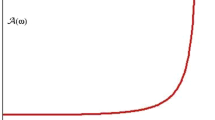Abstract
A model of the early universe in the Einstein theory of gravitation, supplemented by a conformalty invariant version of the Weinberg—Salam model, is considered. The conformai symmetry principle leads to the need to eliminate the Higgs potential from the expression for gravitational action, using the Lagrangian density of the model of Weinberg—Salam electroweak interactions as the material source, and to incorporate the conformally invariant Penrose—Chernikov—Tagirov term. In the limit of flat space, we arrive at the a version of the Weinberg—Salam model without Higgs particle-like excitations. In the conformalty invariant model under consideration, Higgs fields are absorbed by the spatial metric, so one can assume that the masses of elementary particles originate at the time when the evolution of the universe begins.
Similar content being viewed by others
References
V. Pervushin and T. Towmasjan,Int. J. Mod. Phys.,D4, 105 (1995); A. Khvedelidze, V. Papoyan, and V. Pervushin,Phys. Rev.,D51, 5654 (1995).
V. Pervushin et al.,Phys. Lett.,B365, 35 (1996).
A. Khvedelidze, Yu. Palii, V. Papoyan, and V. Pervushin,Phys. Lett.,B402, 263 (1997).
S. Gogilidze, A. Khvedelidze, and V. Pervushin,Phys. Rev.,D53, 2160 (1996); S. A. Gogilidze, A. M. Khvedelidze, and V. N. Pervushin,J. Math. Phys.,37, 1760 (1996).
R. Penrose, in:Relativity, Groups and Topology, Gordon and Breach, London (1964), p. 565; N. A. Chernikov and E. A. Tagirov,Ann. Inst. Henri Poincaré, 9, 109 (1968).
M. Pawlowski and R. Raczka,Found. Phys.,24, 1305 (1994).
V. Pervushin and V. Smirichinski, “On the cosmological origin of the homogeneous scalar field in Unified Theories. “Preprint E2-97–155, Joint Inst. Nucl. Res., Dubna (1997), gr-qc/9704078 (submitted toPhys. Lett. B).
S. Dittmaier, C. Grosse-Kneter, and D. Schildnecht,Z. Phys.,C67, 109 (1995).
T. Levi-Civita,Prace Mat.-Fiz.,17, 1(1906); S. Shanmugadhasan,J. Math. Phys.,14, 677 (1973).
J. W. York, Jr.,Phys. Rev. Lett.,28, 1082 (1972); ibid.,26, 1656 (1971).
S. Gogilidze et al.,Grav. Cosmol. 3, 156 (1997).
S. Weinberg,Rev. Mod. Phys.,61, 1 (1989).
T. J. Broadhurst, R. S. Ellis, D. C. Koo, and A. S. Szalay,Nature (London),343, 726 (1990).
Author information
Authors and Affiliations
Additional information
Translated from Astrofizika, Vol. 41, No. 3, pp. 459–471, July–September, 1998.
Rights and permissions
About this article
Cite this article
Papoyan, V.V., Pervushin, V.N. & Smirichinskii, V.I. Conformally invariant model of the early universe. Astrophysics 41, 299–307 (1998). https://doi.org/10.1007/BF03036099
Received:
Accepted:
Issue Date:
DOI: https://doi.org/10.1007/BF03036099



